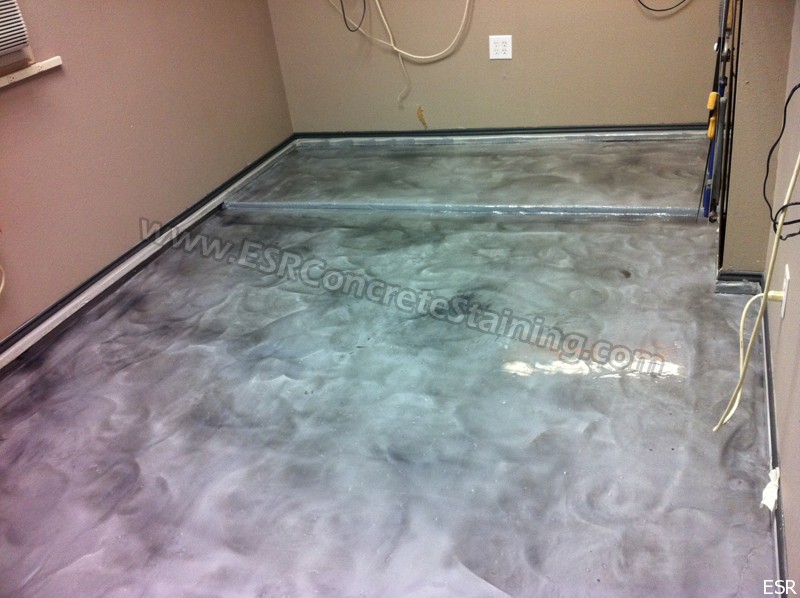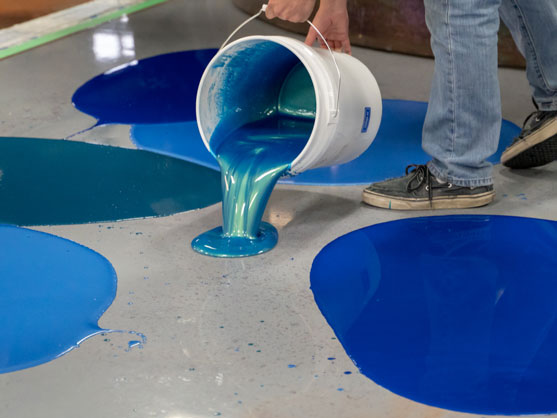What is Pourable Epoxy Flooring?
Pourable epoxy flooring is a type of seamless flooring system that is applied in liquid form and then hardens into a durable, glossy surface. It is made from a combination of epoxy resin and a hardener, which chemically reacts to create a strong and resilient coating. This type of flooring is commonly used in commercial and industrial settings where a high-performance, easy-to-maintain surface is required.
The application process of pourable epoxy flooring involves pouring the liquid epoxy mixture onto the prepared substrate and spreading it evenly with a trowel or squeegee. The material self-levels, meaning it naturally spreads out and fills any gaps or imperfections in the surface. As the epoxy cures, it becomes a solid, seamless layer that is resistant to chemicals, stains, abrasion, and impact.
One of the key advantages of pourable epoxy flooring is its versatility. It can be applied over a wide range of substrates, including concrete, wood, and metal. This makes it suitable for various environments such as warehouses, showrooms, garages, laboratories, and hospitals. Additionally, pourable epoxy flooring is available in different colors and finishes, allowing for customization to match the aesthetic requirements of the space.
Another benefit of pourable epoxy flooring is its low maintenance requirements. The smooth, non-porous surface makes it easy to clean and resistant to dirt, dust, and bacteria buildup. Regular sweeping and occasional mopping are usually sufficient to keep the floor looking clean and polished.
Pourable epoxy flooring is a versatile and durable flooring solution that offers numerous benefits in terms of performance, aesthetics, and maintenance. Its liquid application process allows for seamless and uniform coverage, creating a visually appealing surface that can withstand heavy use and harsh conditions. Whether in a commercial or industrial setting, pourable epoxy flooring is a reliable choice for achieving a high-quality and long-lasting floor.

Benefits of Pourable Epoxy Flooring
- Seamless Surface: Pourable epoxy flooring provides a seamless surface that is not only aesthetically pleasing but also functional. Without any joints or seams, this type of flooring eliminates the risk of dirt, bacteria, or other contaminants getting trapped in the cracks, making it easier to clean and maintain.
- Durability: Pourable epoxy flooring is known for its exceptional durability. It can withstand heavy foot traffic, impact, and abrasion, making it suitable for commercial and industrial environments. This flooring solution is also resistant to chemicals, stains, and moisture, ensuring its longevity and reducing the need for frequent repairs or replacements.
- Versatility: One of the major advantages of pourable epoxy flooring is its versatility. It can be customized to meet various design preferences, including different colors, patterns, and textures. This allows businesses and homeowners to create a unique and visually appealing space that aligns with their specific requirements and branding.
- Safety: Pourable epoxy flooring offers enhanced safety features. It can be formulated with slip-resistant additives to provide a high level of traction, reducing the risk of slips and falls. Additionally, this type of flooring is fire-resistant, making it a safer option for areas prone to fire hazards.
- Cost-effective: In the long run, pourable epoxy flooring proves to be a cost-effective solution. Its durability and low maintenance requirements result in reduced repair and replacement costs. Moreover, its seamless surface and resistance to stains make cleaning quick and easy, saving both time and money on cleaning resources.
- Quick Installation: Pourable epoxy flooring can be installed relatively quickly compared to other flooring options. This is especially beneficial for businesses or homeowners who have time constraints or require minimal disruption to their operations or daily routines.
- Environmental Friendliness: Many pourable epoxy flooring options are eco-friendly. They can be manufactured using sustainable materials and low VOC (volatile organic compound) content, ensuring minimal impact on the environment. This makes pourable epoxy flooring a responsible choice for eco-conscious individuals and businesses.
- Improved Lighting: Pourable epoxy flooring has a high-gloss finish that reflects light, effectively brightening up the space. This can help reduce the need for additional lighting, resulting in energy savings and creating a more pleasant and visually appealing environment.
How to Install Pourable Epoxy Flooring
Preparing the Surface:
- Clear the area: Before starting the installation process, ensure that the floor is completely clean and free from any debris or dust. Remove any existing flooring or adhesives if necessary.
- Repair any damages: Inspect the surface for any cracks, holes, or imperfections. Fill in these areas with a suitable epoxy filler and allow it to cure according to the manufacturer’s instructions.
- Clean thoroughly: Use a degreaser or a detergent to clean the floor surface thoroughly. Ensure that it is completely free from any oils, grease, or other contaminants that may hinder the adhesion of the epoxy.
Applying the Primer:
- Mix the primer: Follow the instructions provided by the manufacturer to prepare the epoxy primer. Ensure that it is thoroughly mixed to achieve a uniform consistency.
- Apply the primer: Using a roller or a brush, apply the epoxy primer onto the floor surface. Start from one corner and work your way towards the exit to avoid stepping on the wet primer. Ensure an even and consistent application.
- Allow curing: Let the primer cure for the recommended time specified by the manufacturer. This is typically around 12 to 24 hours but may vary depending on the specific product.
Pouring the Epoxy:
- Mix the epoxy: Carefully measure and mix the epoxy components according to the manufacturer’s instructions. Use a clean bucket and mix thoroughly to ensure a homogenous mixture.
- Pour the epoxy: Start pouring the mixed epoxy onto the primed surface in a ribbon-like pattern. Work in sections, ensuring that the epoxy is spread evenly across the floor.
- Spread with a squeegee: Use a squeegee to evenly spread the epoxy across the entire area. Move the squeegee in a back-and-forth motion to achieve a smooth and level surface.
- Eliminate bubbles: To remove any air bubbles that may have formed during the pouring and spreading process, use a heat gun or a propane torch. Pass it gently over the surface, keeping it at a safe distance to avoid overheating or damaging the epoxy.
Curing and Finishing:
- Allow curing: Let the epoxy cure for the recommended time specified by the manufacturer. This can vary but usually takes around 24 to 48 hours. Avoid stepping on the epoxy during this curing period.
- Apply a topcoat (optional).
Tips for Maintaining Pourable Epoxy Flooring:
Regular Cleaning:
Pourable epoxy flooring requires regular cleaning to maintain its appearance and durability. Sweep or vacuum the floor regularly to remove dust, dirt, and debris. Use a mild detergent or epoxy-specific cleaner to mop the floor periodically. Avoid using abrasive cleaners or scrub brushes that can damage the epoxy surface.
Prompt Spill Cleanup:
Accidents happen, but it’s important to clean up spills on pourable epoxy flooring as quickly as possible. Epoxy is resistant to stains and chemicals, but certain substances like oil, grease, or acidic liquids can potentially cause damage if left unattended. Wipe up spills immediately with a clean cloth or paper towel, and then clean the area with a mild detergent to ensure no residue remains.
Avoid Heavy Impact:
While pourable epoxy flooring is highly durable, it is still susceptible to damage from heavy impact. Avoid dropping heavy objects directly onto the floor, as this can cause cracks or chips. Use protective mats or pads under heavy equipment or furniture to minimize the risk of damage.
Regular Inspections:
Perform regular inspections of your pourable epoxy flooring to identify any signs of wear or damage. Look for cracks, chips, or areas where the epoxy may be lifting. If you notice any issues, address them promptly to prevent further damage. Contact a professional if necessary for repairs or maintenance.
Use Protective Measures:
To maintain the longevity of your pourable epoxy flooring, it is advisable to use protective measures. Place doormats or rugs at entrances to trap dirt and prevent it from being tracked onto the floor. Use furniture pads or glides under heavy furniture to prevent scratching or scuffing of the epoxy surface. Additionally, consider applying a topcoat or sealant periodically to enhance the floor’s resistance to wear and tear.
Avoid Harsh Chemicals:
When cleaning pourable epoxy flooring, it is crucial to avoid using harsh chemicals or solvents. These can strip away the epoxy’s protective coating or cause discoloration. Stick to gentle, non-abrasive cleaners specifically formulated for use on epoxy surfaces.
Regular Maintenance:
In addition to regular cleaning, pourable epoxy flooring requires routine maintenance to stay in optimal condition. This may involve reapplying a topcoat or sealant every few years to protect the epoxy surface and restore its shine. Follow the manufacturer’s recommendations for maintenance and consult a professional if needed.
Epoxy Floor Installation Over Old Concrete
How Much Epoxy Do I Need to Cover My Floor, Countertop, or Wall
Metallic Epoxy Floor Coating SwedeBro
How to Do Epoxy Flooring (with Pictures) – wikiHow
Related Posts:
- Kilz 1 Part Epoxy Concrete & Garage Floor Paint Reviews
- Epoxy Floor Repair Compound
- Self Leveling Epoxy Floor Patch
- Behr 2 Part Epoxy Garage Floor Coating Reviews
- Epoxy Floor Color Chips
- Rustoleum Metallic Floor Epoxy
- Rust Oleum 1 Gal 1 Part Epoxy Concrete Floor Paint
- Best Way To Clean Epoxy Floors
- How To Apply Epoxy Paint On Garage Floor
- Decorative Epoxy Flooring Systems






